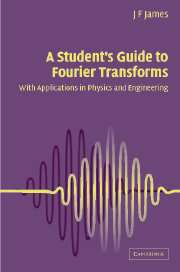
-
Select format
-
- Publisher:
- Cambridge University Press
- Publication date:
- June 2012
- September 2002
- ISBN:
- 9781139164917
- Dimensions:
- Weight & Pages:
- Dimensions:
- Weight & Pages:
You may already have access via personal or institutional login
Book description
Fourier transform theory is of central importance in a vast range of applications in physical science, engineering, and applied mathematics. This new edition of a successful student text provides a concise introduction to the theory and practice of Fourier transforms, using qualitative arguments wherever possible and avoiding unnecessary mathematics. After a brief description of the basic ideas and theorems, the power of the technique is then illustrated by referring to particular applications in optics, spectroscopy, electronics and telecommunications. The rarely discussed but important field of multi-dimensional Fourier theory is covered, including a description of computer-aided tomography (CAT-scanning). The final chapter discusses digital methods, with particular attention to the fast Fourier transform. Throughout, discussion of these applications is reinforced by the inclusion of worked examples. The book assumes no previous knowledge of the subject, and will be invaluable to students of physics, electrical and electronic engineering, and computer science.
Reviews
From reviews of the first edition:‘… elegantly simple.’
Source: New Scientist
‘It is the wide range of topics that makes this book so appealing … I highly recommend this book for the advanced student … Even the expert who wants a deeper appreciation of the Fourier transform will find the book useful.’
Source: Computers in Physics
‘… this is an excellent book to initiate students who possess a reasonable mathematical background to the use of Fourier transforms …’
Source: Microscopy and Analysis
Contents
Metrics
Altmetric attention score
Full text views
Full text views help Loading metrics...
Loading metrics...
* Views captured on Cambridge Core between #date#. This data will be updated every 24 hours.
Usage data cannot currently be displayed.
Accessibility standard: Unknown
Why this information is here
This section outlines the accessibility features of this content - including support for screen readers, full keyboard navigation and high-contrast display options. This may not be relevant for you.
Accessibility Information
Accessibility compliance for the PDF of this book is currently unknown and may be updated in the future.


